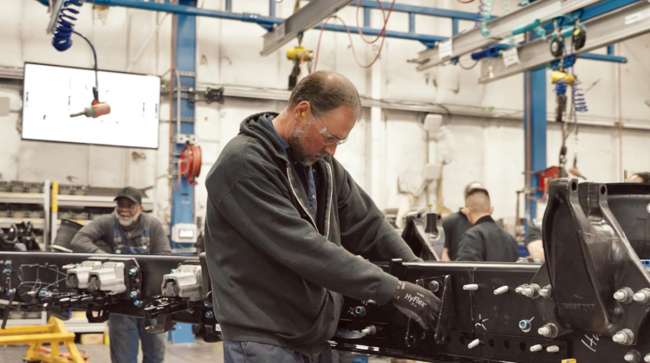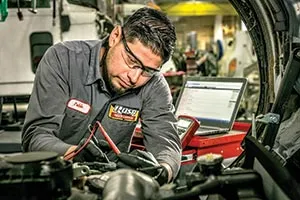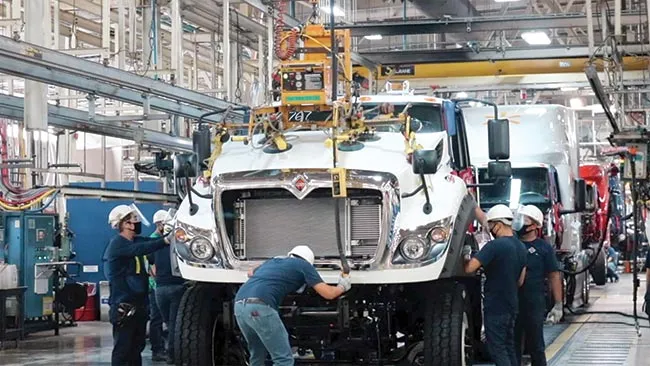Special to Transport Topics
Upcoming NOx Regulations Present Challenges for OEMs

[Stay on top of transportation news: Get TTNews in your inbox.]
Fleets and Class 8 truck manufacturers are running into many challenges preparing for the updated NOx regulations from the Environmental Protection Agency, coming into effect in 2027.
Allen Schaeffer, executive director of the industry advocacy group the Diesel Technology Forum, noted the new EPA emissions rules are but one of the major regulatory considerations facing manufacturers, along with the current proposed rule for GHG Phase 3 and California Air Resources Board (CARB) mandates.
“The new EPA rules adopted in December 2022 require pretty significant increases in useful life and warranty periods in addition to requirements for lower emissions,” he said. “Both of which have major implications for overall [fleet and OEM] business strategies.”
Schaeffer believes the segment facing the toughest challenges will be those fleets with 20 trucks or fewer, which comprise 90% of industry capacity. “What they think and how they make decisions is going to be different than what the top 100 carriers think about,” he explained. With California initially implementing tighter NOx rules in 2024, the industry will have a few pre-2027 years of learning, “a canary in the coal mine experience to see what these low-NOx trucks look like and how they perform,” he said.

Schaeffer
The industry is likely to see a refinement and optimization of how today’s emissions control systems are arranged and work together, notes Ann Rundle, vice president of electrification and autonomy for ACT Research.
“The challenge is to figure out how you get a more complete burn in the combustion chamber so there is less to treat downstream,” she noted, adding that includes continuing to utilize and refine proven solutions like cylinder deactivation, variable valve activation and other functional engine designs, along with reimagining the sequencing and performance of aftertreatment systems.
Rundle expects to see improvements with dual dosing systems coming into play. In addition, she forecasted more use of 48-volt systems to heat catalysts “to get a more complete conversion so there is less NOx going out the tailpipe.”
She believes these higher-powered systems are needed to provide preheating “so when the truck starts cold, the aftertreatment system is up and running and functional right at the start as opposed to after the truck is warmed up.”
Developing these next-generation NOx and GHG solutions “will take quite a bit of engineering,” yet, “the engine block will still essentially be the same,” Rundle said.

Rundle
While “there are technologies being applied today to solve the problems, it isn’t a trivial effort,” she added. These complex systems will come with a hefty price tag, says Rundle, as much as an additional $25,000 to $30,000 per truck.
The nation’s truck dealerships are not sitting on the sidelines, said Scott Chowaniec, vice president of vocational products and EV for Rush Enterprises. “We have people who participate in every CARB and EPA meeting we can,” he said. “And we have our own technical personnel meeting with product teams at the OEMs so we can understand what’s the technical path today and tomorrow, so we can plan infrastructure and resources at our facilities to be ready for the new products and regulations.”
Rush represents Peterbilt and Navistar for Class 8 trucks and has more than 150 dealerships in the U.S. and Ontario.
Chowaniec observed engine producers working with EPA and CARB, who currently have somewhat different standards, to get them to align and “common-ize” the regulations “so we don’t have different technical paths for different states.”
“In 2024, California and Oregon will implement the CARB standard,” he explained. “In 2025, Massachusetts will join in. Those three states represent 15% of all vehicle registrations.”
When the CARB mandate arrives, operators will have to comply and meet the standard, or use a combination of credits and other mitigation measures, Chowaniec noted.
He believes both new technology and refinements of current systems will be needed to meet the new emissions reduction goals. He noted that in the past, engines would be run in a test cell, emissions measured, and then the engine certified (or not) based on that performance. However, trucks and their engines wear and can’t match the initial test results.

Rush Enterprises said they met often with OEM product teams in anticipation for new products and regulations. (Rush Enterprises)
“From the moment you turn on that vehicle through the full life of it, you have to ensure that whatever comes out of that tailpipe continues to meet the performance achieved in that initial test cell,” Chowaniec said. “That ensures as the truck ages, the emissions still fall within the regulations. That particular challenge will require new technology.”
In any event, Chowaniec estimates the cost next year for a 2024-compliant Class 8 truck “will be anywhere from $12,000 to $25,000 more per truck. “[It’s] basically the same truck you bought this year. And that’s if you can get a build slot,” he said.
As the industry rolls into 2024 and the 2027 regulations loom closer, fleets already are trying to figure out how to plan for fleet replacement needs to ensure they have compliant trucks and sufficient reliable operating capacity. Could we see a repeat of the “pre-buy” rush that occurred in the 2006-2007 model year?
“If we were not already dealing with allocation and supply chain disruptions, we’d have a pre-buy now,” Chowaniec commented. “Most OEMs have a limited number of vehicle slots available. For most of our customers, the first half is sold out, and the second half is locked down.”
However, he sees some potential moderation in that demand. “With certain manufacturers, if a customer canceled a slot, there were 10 people in line waiting to take it,” Chowaniec said. “Now there might be three. People are still in line but [demand is] not quite as robust.” He anticipates “a fairly significant pre-buy ahead of 2027.”
An Intricate Web of Solutions
The complexity of the challenge in meeting the new emissions regulations means that the days when an OEM could simply “bolt on” a new piece of equipment to achieve compliance have passed, observed Michael Grahe, executive vice president of operations at Navistar.

Grahe said the complexity of the challenge in meeting the new emissions regulations means that the days when an OEM could simply “bolt on” a new piece of equipment to achieve compliance have passed. (Navistar)
"Today’s powertrains and vehicles are an intricate web of solutions that must balance and add resiliency to each other to meet customer and regulatory expectations,” he explains. They are complex, highly engineered, and deeply integrated “to deliver the best economy, performance, simplicity and serviceability” while meeting ever more challenging and tighter regulatory requirements.
“It’s reasonable to assume that the increased costs associated with technology development will lead to higher-priced equipment and that will have an impact on the number of trucks fleets are able to afford,” noted Sean Waters, vice president of product compliance and regulatory affairs at Daimler Truck North America (DTNA). “That would likely lead to older trucks remaining in service longer, and create favorable conditions for the used truck market.”
Lingering supply chain issues also could have an impact on production and availability. “What we’ve been experiencing in the supply chain, particularly for early pandemic-induced shortages of critical components like semiconductors, is that it has begun to stabilize,” Waters said. “We’re not completely free from these issues but judging by the way things have progressed recently ... resiliency and to some degree redundancy will continue to be built into the supply chain.”
As for DTNA’s approach to addressing the EPA’s Clean Trucks Plan, Waters described them as “challenging targets,” but emphasizes the OEM is ready to help further reduce emissions from conventionally powered vehicles.
Want more news? Listen to today's daily briefing above or go here for more info
DTNA’s Heavy-Duty Engine Platform, Waters said, “gives us an efficient, proven and tested basis with which to work” in meeting increasingly more stringent emissions controls. “We believe it will serve as the basis for future engine development,” he said.
As the industry moves ahead to continue to reduce truck emissions and eventually reach the goal of zero emissions, Waters said that this will help to ensure American competitiveness and economic prosperity.
“It’s clear that regulators, truck manufacturers, suppliers, fleets and society as a whole would like to ultimately see our industry decarbonize,” he comments. “It’s a goal we share, and our own company, as well as others are offering viable products for select applications today.”




